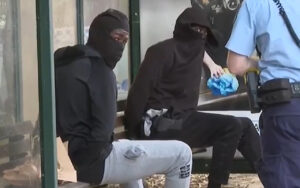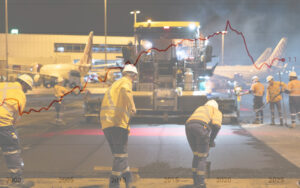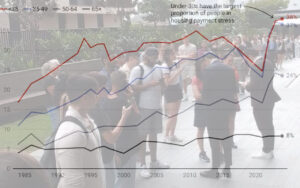A Sydney developer got a massive high-rise approved by the NSW Labor government despite part of the property being frozen by the state’s crime commission, objections from locals, and having Australia’s deepest carpark in a zone recently slated for zero parking.
Construction giant Billbergia now has two more major developments in the same area worth more than $5 billion set for fast-track treatment, and is emerging as a major beneficiary of Premier Chris Minns’ push to build 377,000 homes in five years by overriding local councils in order to alleviate the states housing crisis.
In March Billbergia managed to get a $295 million 48-storey building with a 12-level underground carpark approved for the already-overcrowded inner west suburb of Rhodes under the government’s State Significant Development (SSD) scheme, where applications are determined by the Minister for Planning.
The tower, directly opposite Rhodes Railway Station, will be built on two amalgamated blocks of land bought by Billbergia in 2023 and 2024 for a combined $50.91 million, and will contain 313 units in a postcode where the median price is approaching $1 million.
But one quarter of the second block is still owned by a company originally run by property developer and accused drug smuggler Savas Guven, and subject to a NSW Crime Commission caveat. Guven is due to face court again next month.
The Blaxland Road site was originally proposed as a 37-storey tower, but was given SSD consent to add another 11 floors, just months after a Department of Planning delegate inserted a clause amending overshadowing rules in the Canada Bay Local Environmental Plan that appears to have benefited the building.
The project was also given consent to build a 257-bay underground carpark, the equal deepest in Australia, with the planning department disregarding recommendations from Transport for NSW and in the City of Canada Bay Council’s Development Control Plan made as far back as 2017 that there be no new parking within 400 metres of the station.
The zero car parking provision was noted in a traffic and transport report for Rhodes East by Jacobs commissioned in the same year, and in the Rhodes East Priority Precinct Investigation Area Plan.
The then-Department of Planning, Industry & Environment then said in 2019 that Rhodes train station and the local road network were already over-capacity during peak periods, with patronage at the station having increased 1,000% over 15 years from 2,360 trips per day to 23,625.

Neither the council nor Transport for NSW objected to the project on those grounds, but a number of local residents filed submissions objecting to the height of the building, the blocking of sun, pressure on infrastructure, and negative effects on the liveability of the suburb.
“The council and government needs to consider the interests and well being of the residents who actually live in the area (who they are supposed to represent and who vote), rather than the financial self interest of developers and the easy money for the council (ie. rates) by allowing as many units as possible on a small footprint of land” wrote one resident.
“Massive high rise towers are a ‘quick fix’ and political point scorer for the government to brag about quickly solving the housing problem. Development in any suburb must be practical and sustainable in terms of services and resources in the area and the impact it will have for current and future local residents.”
A second submission warned that the development “will not only overcrowd an already saturated area but also disproportionately benefit overseas investors, making the units unaffordable and inaccessible to Australian citizens”.
A third complained about over-crowding, and complained that high-density developments kept getting approved despite local opposition, referring to a previous high-rise that went ahead despite 77% of the submissions to council being in opposition.
“Why is that, and how could it be that a majority objected and the proposal still went ahead?” they asked.
Another objection noted links between Billbergia and former Canada Bay Mayor Angelo Tsirekas, who in 2023 was found by the Independent Commission Against Corruption (ICAC), to have engaged in serious corrupt conduct along with businessman Joseph Chidiac.
ICAC’s Operation Tolosa found in 2023 that Tsirekas “partially exercised his official functions to favour the interests of Billbergia Group”, and that Billbergia paid Chidiac $550,000 between 2015 and 2018 to resolve disputes and acquire properties.
ICAC recommended the ex-Labor mayor, a protégé of corrupt politician Eddie Obeid, be removed from office and said it would seek advice from the Director of Public Prosecutions on whether Tsirekas should be prosecuted, but no charges have been laid.

Since the Blaxland Road site was approved in March Billbergia has filed new SSD Applications to add to a $3 billion development in Rhodes that will end up with 1,600 units and a shopping centre, and to build a $2.2 billion residential and retail precinct in nearby Concord West with 1,400 dwellings.
Demolition has already been completed in preparation for the planned tower at the Rhodes Central site, which Billbergia said “embodies our commitment to creating connected communities and delivering housing diversity amid Sydney’s housing crisis”.
The NSW government’s Housing Delivery Authority (HDA), announced in November last year, allows housing developments in Greater Sydney with a capital cost of $60 million or more to be declared as State Significant and be assessed by a three-person HDA panel instead of by councils.
Opposition leader Kellie Sloane said on Friday responded to revelations that a senior planning official used an unauthorised AI tool to collate information before the HDA by calling for an independent review into the nearly 600 HDA-approved developments to be made public.
“The Housing Delivery Authority was established by the Government to offer a streamlined assessment process, but as part of that pathway the Government needs to ensure the highest integrity and transparency to support the decisions that are being made,” Ms Sloane said.
Shadow Minister for Planning and Public Spaces, Scott Farlow, said the HDA needed more resources to prevent more errors being made.
“Since its inception we’ve seen the HDA approve proposals over land that wasn’t controlled by the applicant, misdescribe locations and the approved height of applications,” Mr Farlow said.
“This is clear evidence that while the HDA has dealt with nearly 600 expressions of interest, they haven’t been provided with the resources to do their job properly.”
Header image: Left, right, the Blaxland Road proposal (NSW Planning Department).
























